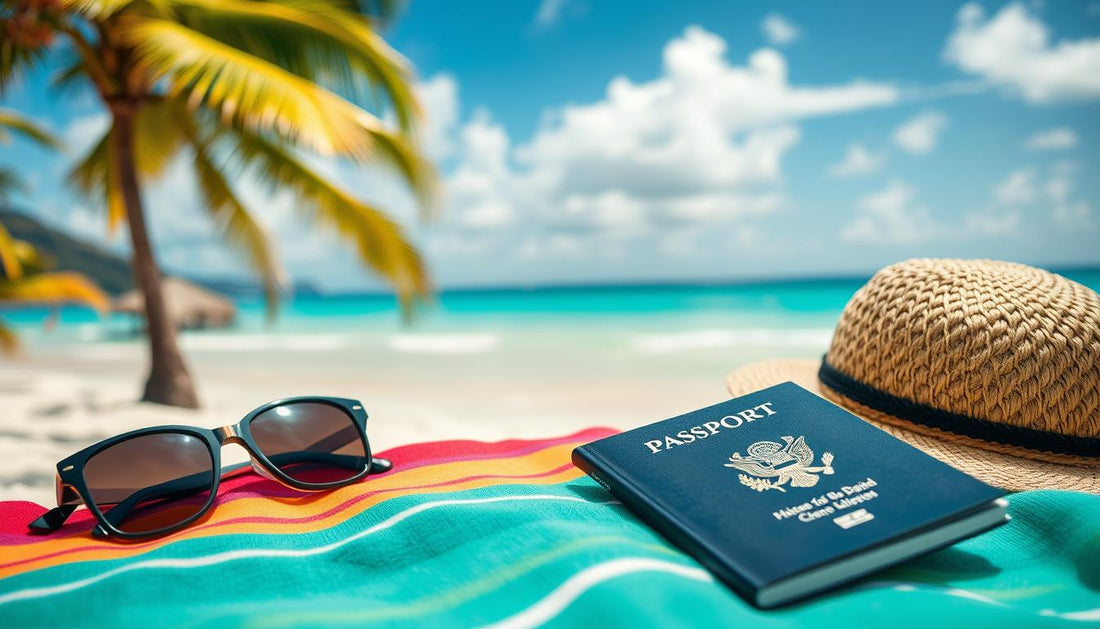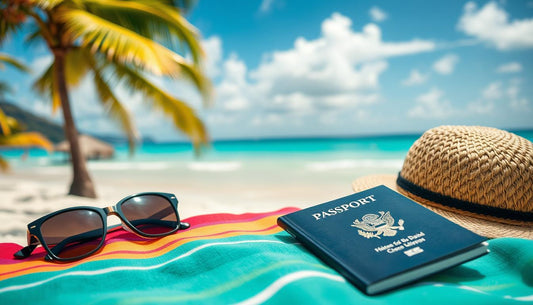Planning a trip to Hawaii, the 50th state of the U.S., can be an exciting experience. However, many travelers are often confused about the documentation required for their journey.
As a tropical paradise, Hawaii is a popular destination for American citizens and international visitors alike. While it's easy for U.S. citizens to travel to Hawaii with a valid government-issued ID, the requirements can vary depending on your travel circumstances.
This comprehensive guide will address the travel documentation requirements for different types of travelers, including U.S. citizens, permanent residents, and international visitors. Whether you're flying directly or taking a cruise, understanding the necessary identification will ensure a smooth journey.
Hawaii's Status as a U.S. State
Understanding Hawaii's position as a U.S. state is crucial for determining travel requirements. As the 50th state to join the United States, Hawaii's status affects how U.S. citizens and others travel to the islands.
When Hawaii Became a State
Hawaii became a U.S. state on August 21, 1959, after being a U.S. territory since 1898. This transition to statehood was a significant event, marking Hawaii's integration into the United States as a fully incorporated state. The historical context of Hawaii's statehood is essential for understanding its current status.
Legal Travel Implications
As a U.S. state, Hawaii is subject to the same travel regulations as other states, meaning that U.S. citizens do not need a passport to visit. Key implications include:
- No passport is required for U.S. citizens traveling to Hawaii.
- Hawaii is treated as a domestic destination, simplifying travel for U.S. citizens.
- The legal status of Hawaii as a state clarifies travel documentation requirements.
Understanding these implications helps travelers prepare appropriately for their trip to Hawaii.
Do You Need a Passport to Go to Hawaii?
For those planning a trip to Hawaii, a crucial question is whether a passport is required. The answer largely depends on your citizenship status and where you're traveling from.
For U.S. Citizens
As a U.S. citizen, you don't need a passport to travel to Hawaii since it's a domestic destination. You can travel to Hawaii with a valid government-issued ID, such as a driver's license. This is because Hawaii is one of the 50 states of the United States, and traveling there is considered domestic travel, just like going to any other state.
For Permanent Residents
Permanent residents of the United States also don't need a passport to visit Hawaii. You can travel to the islands with your permanent resident card (green card) and a valid government-issued ID. The same rules that apply to U.S. citizens generally apply to permanent residents, making Hawaii accessible without the need for international travel documentation.
Acceptable Forms of Identification for Domestic Travel
For a smooth Hawaiian vacation, understanding the required identification is key. When traveling within the United States, you'll need a valid form of photo ID for various activities, including checking in for your flight, passing through TSA security, renting a car, and checking into your hotel.
Driver's License Requirements
A valid driver's license is one of the most widely accepted forms of identification. Ensure your license is not expired and is issued by a U.S. state or territory. Some states offer enhanced driver's licenses that can be used for land and sea crossings, but these are not necessary for domestic air travel to Hawaii.
State ID Cards
For those who don't drive, a state ID card is a suitable alternative. These cards are issued by state DMVs and serve as a valid form of identification for domestic travel. Like driver's licenses, they must be current and not expired. It's also worth noting that some states issue REAL ID-compliant state ID cards, which will be discussed later in the context of the REAL ID Act.
REAL ID Act and Its Impact on Hawaii Travel

As you plan your trip to Hawaii, it's essential to understand the REAL ID Act and how it affects your domestic air travel. The REAL ID Act, passed by Congress in 2005, sets standards for identification documents, such as driver's licenses.
What is a REAL ID?
A REAL ID is a form of identification that meets federal standards. It's marked with a star at the top of the card, indicating compliance. To fly within the United States, including to Hawaii, you'll need a REAL ID-compliant driver's license or another acceptable form of ID.
Current Implementation Timeline
The TSA has set a deadline for REAL ID enforcement as May 3, 2023. This means that every air traveler 18 years of age and older will need a REAL ID-compliant license or another acceptable form of ID to fly within the United States. To obtain a REAL ID-compliant card, contact your state's driver license agency.
- Check if your ID is REAL ID-compliant.
- Contact your state's driver's license agency to obtain a REAL ID-compliant card if necessary.
- Consider alternative acceptable forms of ID, such as a passport.
Traveling to Hawaii from the Continental U.S.
For travelers from the continental U.S., flying to Hawaii is a convenient option, with several major airlines providing direct flights. You can travel to Hawaii without a passport, as it's considered a domestic destination.
Direct Flights
Direct flights to Hawaii are available from major U.S. cities like Los Angeles, Seattle, and San Francisco. These flights operate under domestic travel regulations, so you won't need a passport. Major airlines such as Hawaiian Airlines, Alaska Airlines, and United Airlines offer direct services, making it easy to reach Hawaii from the mainland.
Connecting Flights
If you're flying from the East Coast or Midwest, you might have a connecting flight with a layover in a western U.S. city before continuing to Hawaii. Airlines like American Airlines, Delta Air Lines, and Southwest Airlines offer connecting flights to Hawaii. You should expect to follow standard domestic security procedures, and the same identification requirements apply regardless of the Hawaiian island you're visiting.
To make your long-haul flight to Hawaii more comfortable, consider booking a seat with extra legroom or upgrading to a higher class of service. Additionally, be sure to stay hydrated and move around the cabin periodically during your flight.
Unlimited Data eSIM from RAPIDeSIM
The eSIM USA is becoming increasingly popular for travelers thanks to its simplicity and fast activation. Instead of inserting a physical SIM card, you can activate your plan instantly by scanning a QR code. It's compatible with most newer smartphones including iPhone 13 and up, as well as recent Samsung Galaxy models.
You can check if your device supports eSIM via our Compatibility Checker.
Why choose an eSIM from RAPIDeSIM ?
- Instant activation without visiting a store
- No need to remove your current SIM
- Flexible prepaid data plans tailored for tourists
- Strong 4G/5G coverage in major cities and tourist areas
- No roaming charges or unexpected fees
>>Buy an international eSIM<< Get 5% OFF. Code: INTERNETEVERYWHERE25
When You DO Need a Passport for Hawaii
While Hawaii is a U.S. state, there are specific situations where you'll need a passport to travel there. Understanding these scenarios is crucial for a smooth journey.
International Travel to Hawaii
If you're traveling directly to Hawaii from a foreign country, you'll need a valid passport. This applies to U.S. citizens coming from Canada, New Zealand, Australia, or any other international destination. Your passport will be required both upon arrival in Hawaii and at the departure airport.
Traveling Through Another Country First
Even if Hawaii is your final destination, traveling through another country first may require a passport. For instance, if you drive to Canada and then fly to Hawaii, you'll need to present a valid passport. This is because your journey involves international travel, triggering passport requirements.
Documentation Requirements for Non-U.S. Citizens

Non-U.S. citizens need to be aware of the specific requirements for traveling to Hawaii. If you're not a U.S. citizen, visiting Hawaii requires additional documentation. Most non-U.S. citizens need a valid passport to enter the United States, including Hawaii.
Visa Requirements
Depending on your nationality, you may also need a passport and a visa to enter Hawaii. Visa requirements vary based on your country of origin. It's essential to check if you need a tourist visa or another type of entry permit.
ESTA Authorization
Some travelers from countries participating in the Visa Waiver Program may be eligible for ESTA (Electronic System for Travel Authorization) if arriving by air or cruise ship. ESTA simplifies the process for eligible visitors, but it's crucial to apply before your trip.
Understanding these requirements is vital for a smooth journey to Hawaii. Hawaii follows the same immigration rules as the rest of the United States, so it's essential to comply with federal regulations.
Special Considerations for Canadian Citizens
As a Canadian citizen planning to visit Hawaii, it's essential to understand the specific travel requirements that apply to you. When traveling to Hawaii, Canadian citizens must adhere to specific documentation requirements. You are required to carry a valid passport or a NEXUS card.
Passport and NEXUS Card Options
Canadian citizens have two primary documentation options for traveling to Hawaii: a valid passport or a NEXUS card. A NEXUS card is beneficial for expedited entry into the U.S. and is available to pre-approved, low-risk travelers.
Length of Stay Limitations
For Canadian citizens, the length of stay in Hawaii is limited to less than 6 months when carrying a passport or NEXUS card. It's crucial to be aware of these limitations to avoid any entry issues.
| Documentation | Length of Stay | Benefits |
|---|---|---|
| Valid Passport | Less than 6 months | Standard travel document |
| NEXUS Card | Less than 6 months | Expedited U.S. entry |
Cruise Ship Travel to Hawaii

Traveling to Hawaii by cruise ship is a popular vacation choice, but what documents do you need? When arriving in Hawaii via cruise, the documentation requirements differ based on your citizenship status and the cruise itinerary.
Documentation for U.S. Citizens on Cruises
For U.S. citizens, a government-issued ID, such as a driver's license, and proof of citizenship, like a birth certificate, are typically sufficient for cruises that remain within Hawaiian waters. For example, the Pride of America by NCL cruise line travels only within Hawaii and does not require a passport.
International Cruise Requirements
International cruises that make stops outside of Hawaii or the U.S. require a passport. It's also important to check with your cruise line for their specific documentation policies, as they may vary. Having a passport is always the safest option, even when not strictly required.
- Check your cruise line's documentation requirements.
- Understand the difference between domestic and international cruise requirements.
- Consider obtaining a passport for international cruises or if you're unsure about your itinerary.
ID Requirements for Children Traveling to Hawaii
As a parent or guardian, it's crucial to know the ID requirements for children traveling to Hawaii to avoid any last-minute hassles. Children traveling with adults can have different identification requirements than those traveling alone.
Minors Under 18
For minors under 18 traveling with a companion who has a valid ID, Hawaiian Airlines states that children do not need an ID. However, carrying some form of ID, like a school ID card, is recommended. This can help in various situations during travel.
Infants and Proof of Age
If you're traveling with a lap infant, you may be asked for proof of the child's age. Carrying a copy of the birth certificate is advisable as it serves as valid proof. Ensuring you have the necessary identification documents for all travelers, including infants, can make your journey smoother.
Backup Identification Options
Multiple forms of identification can be a lifesaver when traveling to Hawaii. While a driver's license is typically sufficient for domestic travel, having backup identification can prevent disruptions in case your primary ID is lost or stolen.
Why Carry Multiple Forms of ID
Carrying multiple forms of ID is crucial for a smooth travel experience. If you lose your primary ID, a backup can help you pass through TSA checkpoints at the airport. It's also useful for other activities that may require identification during your trip.
Recommended Backup Documents
Consider carrying a passport or another official form of identification as a backup. Other recommended documents include a state ID or a NEXUS card, if applicable. You may also want to make digital copies of your important documents and store them securely.
| Document Type | Usefulness | Additional Notes |
|---|---|---|
| Passport | High | Useful for international travel and as a backup ID |
| State ID | Medium | Can serve as an alternative to a driver's license |
| NEXUS Card | High | Useful for expedited customs processing |
What to Do If You Lose Your ID While in Hawaii
In the event your ID goes missing in Hawaii, being aware of the necessary steps to take can help minimize disruptions to your travel plans. Losing your identification can be stressful, but there are established procedures to follow that can help resolve the issue efficiently.
Emergency Procedures
If you lose your ID, immediately report it to the local authorities. Filing a police report is crucial as it provides a record of the incident, which can be helpful for insurance purposes or if your ID is used fraudulently. You should also contact your home state's DMV to report the loss and inquire about obtaining a temporary or replacement ID.
TSA Special Procedures
The Transportation Security Administration (TSA) has protocols in place for travelers who have lost their ID. You will be required to undergo additional screening, which may include answering security questions to verify your identity. It's essential to arrive at the airport with extra time to spare, as this process can be lengthy.
| Action | Description | Timeline |
|---|---|---|
| Report to Local Authorities | File a police report for lost ID | Immediately |
| Contact Home State DMV | Inquire about temporary or replacement ID | As soon as possible |
| TSA Screening | Undergo additional security screening | At airport security checkpoint |
Common Misconceptions About Hawaii Travel Requirements
Many travelers to Hawaii have misconceptions about the travel requirements for this popular destination. Some believe that because Hawaii is an island state, it requires different travel documentation than other U.S. states.
One common misconception is that Hawaii is considered a "foreign" destination. However, as part of the United States, Hawaii follows the same domestic travel rules as other states.
Hawaii as a "Foreign" Destination
Some visitors mistakenly believe that Hawaii's geographic isolation means it requires international travel documentation. However, for U.S. citizens, a state Driver's License or ID card is sufficient for traveling to Hawaii. You don't need a passport unless you're coming from or going to an international destination.
Special Location Access Requirements
Another misconception is that certain locations within Hawaii, such as national parks or protected areas, require special documentation. In reality, these areas follow the same rules as their counterparts on the mainland. You can visit Hawaii's beautiful destinations with the same ID you'd use for domestic travel on the mainland.
Preparing Your Travel Documents
To have a smooth and enjoyable trip to Hawaii, preparing your travel documents in advance is key. Ensuring you have all necessary documents ready will help you avoid last-minute complications at the airport or during your travels.
Document Checklist
Before traveling to Hawaii, it's essential to gather and verify all required travel documents. Your checklist should include a valid government-issued ID, such as a driver's license or state ID, and potentially a passport if you're traveling from outside the U.S. or through another country first.
- Valid driver's license or state ID
- Passport (if required)
- Travel itinerary
- Hotel reservation or accommodation details
- Travel insurance documents (if applicable)
Timing and Expiration Dates
Checking the expiration dates of your travel documents well in advance is crucial. For U.S. citizens, a driver's license or state ID should be valid for the duration of your stay. If you're traveling with a passport, ensure it's valid for at least six months beyond your planned departure date from Hawaii.
| Document Type | Validity Requirement | Renewal Timeline |
|---|---|---|
| Driver's License/State ID | Valid during stay | At least 1 month before expiration |
| Passport | Valid 6 months beyond departure | At least 2-3 months before expiration |
Current COVID-19 Travel Requirements
With the ever-changing landscape of COVID-19 restrictions, understanding the latest travel requirements to Hawaii is crucial. As the situation continues to evolve, it's essential to stay informed about the current regulations to ensure a smooth and enjoyable trip.
Domestic Travel Updates
Starting next week, all COVID restrictions associated with domestic travel to Hawaii will end. You won't be subject to any COVID screening, and proof of vaccination or testing will no longer be required. This change simplifies travel planning for U.S. citizens and residents.
International Arrival Protocols
However, international arrivals are still subject to certain requirements. Before boarding a flight to the United States, you'll need to show a negative COVID-19 test result taken no more than 1 day before travel. Alternatively, if you've had documented recovery from COVID-19 in the past 90 days, you can provide that information. It's crucial to check the latest guidelines before your travel day to ensure compliance.
Conclusion
Hawaii, known for its stunning beaches and volcanoes, has specific travel requirements that you should be aware of. As a U.S. state, citizens traveling directly from the mainland don't need a passport. However, certain situations require a passport, such as international travel or connections through other countries. It's crucial to have the proper identification for your specific situation. Prepare your documentation well in advance and consider carrying backup identification. Always check for updated travel hawaii requirements before your departure date to ensure a smooth trip.
Wishing you a wonderful Hawaiian vacation with the peace of mind that comes from being properly prepared, remember that while Hawaii feels exotic, it follows the same travel rules as any other U.S. state when traveling hawaii.








